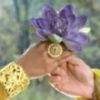Chandragupta Maurya
| Chandragupta Maurya | |
|---|---|
| Mauryan Emperor | |
| Reign | 320'298 BCE |
| Born | 340 BCE |
| Birthplace | Magadha, Bihar |
| Died | 298 BCE (aged 42) |
| Place of death | Shravanabelagola, Karnataka |
| Predecessor | Dhana |
| Successor | Bindusara |
| Consort | Durdhara |
| Royal House | Mauryan dynasty |
| Religious beliefs | |
Chandragupta Maurya (), (born c. 340 BCE, ruled c. 320 BCE,[1] ' 298 BCE[2]) was the founder of the Maurya Empire. Chandragupta succeeded in conquering most of the Indian subcontinent. According to some ancient Buddhist texts he claims descent from the Shakya rulers of solar race. Buddhist texts describes about his lineage with the "Moriya" clan of Shakya rulers hence he was the scion of the solar race of Kshatriya's. Having defeated the Greek satrap in the Khyber mountains around 303 BCE, Chandragupta was crowned King at Taxila. As a result, Chandragupta is considered the first unifier of India and its first genuine emperor.[3] In foreign Greek and Latin accounts, Chandragupta is known as Sandrokyptos
Prior to Chandragupta's consolidation of power, small regional kingdoms dominated the northwestern subcontinent, while the Nanda Dynasty dominated the middle and lower basin of the Ganges.[5] After Chandragupta's conquests, the Maurya Empire extended from Bengal and Assam[6] in the east, to Afghanistan and Balochistan in the west, to Kashmir and Nepal[7] in the north, and to the Deccan Plateau in the south.[8]
His achievements, which ranged from conquering Macedonian satrapies in the northwest and conquering the Nanda Empire by the time he was only about 20 years old, to achieving an alliance with Seleucus I Nicator and establishing centralized rule throughout South Asia, remain some of the most celebrated in the history of India. Over two thousand years later, the accomplishments of Chandragupta and his successors, including Ashoka the Great, are objects of great study in the annals of South Asian and world history.
source : wikipedia
________________________________________________
Chandragupta Maurya was the founder of the Maurya Empire in India. He is credited with bringing together the small fragmented kingdoms of the country and combining them into a single large empire. As per the Greek and Latin accounts, King Chandragupta Maurya is known as Sandracottos or Andracottus. During his region, the Maurya Empire stretched from Bengal and Assam in the East, to Afghanistan and Balochistan in the West, to Kashmir and Nepal in the North and to the Deccan Plateau in the South. Read on this biography cum life history of Chandragupta Maurya to know more about the great king:
Conflicting Views about His Lineage
Chandra Gupta Maurya was born in 340 BC. However, there is not much information about his ancestry. Some of the historians believe that he was an illegitimate child of a Nanda prince and his maid, Mura. Others believe that Chandragupta belonged to Moriyas, a Kshatriya (warrior) clan of a little ancient republic of Pippalivana, situated between Rummindei (Nepali Tarai) and Kasia (Gorakhpur district of Uttar Pradesh). Two other views are that he belonged either to the Muras (or Mors) or to the Kshatriyas of the Indo-Scythian lineage. Last but not the least, it is also claimed that Chandragupta Maurya belonged to the Assakenoi or Ashvaka Kshatriya clan of Swat/Kunar valley.
Early Life
There is not much information about the childhood days of King Chandragupta Maurya. As per the traditional records, Chanakya, a teacher at Takshila University, found him in the Magadha kingdom. Thereafter, Chanakya brought Chandragupta to Takshila, where he took him under his guidance. Further reports state that Chandragupta once met Alexander the Great and told him on his face that the ruling of the Nanda Empire was faulty.
Foundation of the Maurya Empire
A major part of the credit for the building of the Maurya Empire goes to Chanakya. He was a teacher at the Takshila University when Alexander started invading India. Since the King of Takshila and Gandhara had surrendered to Alexander, Chanakya sought help from other kings to unite and fight against him. Porus (Parvateshwar), a king of Punjab, challenged Alexander at the Battle of the Hydaspes River. However, he got defeated in the battle. Chanakya also sought help from Dhana Nanda, the ruler of Nanda Empire, but was refused. After this incident, he started instilling the idea of building an empire that could fight against foreign invasion into his disciple, Chandragupta. Chanakya became his chief adviser or prime minister.
Conquests
Chandragupta Maurya defeated the Macedonian satrapies in the northwest of the Indian subcontinent in 317 BC. Thereafter, he turned his attention towards Northwestern India. Chandragupta allied with the Himalayan king Parvatka and launched an attack against Dhana Nanda of the Nanda Empire. The battle ended around 321 BC, with the siege of the capital city of Kusumapura and the conquest of the Nanda Empire. Thus was born the powerful Maurya Empire in Northern India.
Conquest of Seleucus Eastern Territories
After the conflict with Seleucus in 305 BC, Emperor Chandragupta Maurya extended his empire towards Seleucid Persia. Through a treaty sealed in 305 BC, Seleucus gave up the country around the Indus River to Chandragupta, including the Hindu Kush, present day Afghanistan and the Balochistan province of Persia. In return, he received five hundred war elephants, increasing his military strength.
Southern Conquests
After annexing the eastern Persian
provinces Seleucus, Chandragupta's empire stretched across the northern
parts of Southern Asia, from the Bay of Bengal to the Arabian Sea.
Thereafter, began his conquests in south, beyond the Vindhya Range and
into the Deccan Plateau. Most of the Southern Asia got united under the
rule of Chandragupta Maurya.
Death
It is believed that in the last
days of his life, King Chandragupta Maurya gave up his throne and
adopted asceticism under the Jain saint, Bhadrabahu Swami. He breathed
his last in 298 BC at Shravanabelagola (in present day Karnataka),
ending his days of self-starvation. A small temple marks the cave
(called Bhadrabahu Cave) where he died.
source : http://indiatourdirect.com/?p=199


















comment:
p_commentcount